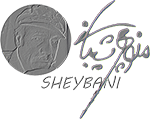

Sheybani is a multi-disciplinary artist and poet who belongs to the movement of Modern Art in Iran. "In his fruitful life, he grabbed multiple branches of the tree of Art and experienced with restlessness multiple fields of art." (Babachahi, Goharan)
Poetry
He was one of the youngest poets of his generation who launched Iran's new modern poetry
movement.
Sheybani is known as a disciple of contemporary poet Nima Youshij, who did not limit himself to
Nima's suggested poetic structure and developed his own.
He was the first poet who experimented with free verse or White Poetry.
The majority of Sheybani's themes of his early poetry are humanitarian (see Jaraggeh book) and
influenced by poet Lahouti.
Dramatic art
He authored the first libretto for the opera written in the Persian language entitled "The Peasant
Festival" (Jashne Dehgan),
played during the inauguration of the first Iranian opera house “Talar Roudaki”.
He also wrote the Persian version of the narrative for the “Sound and Light” show performed at
the ruins of Persepolis in 1971.
He received the Screenplay Award at the Tus Festival for his epic-themed Sohrāb Tragedy in 1977,
published later as a book.
Visual art
Sheybani belonged to the generation of modern painters who created the new wave of Modern
Art in Iran after the Second World War and was one of the pioneers of impressionism in Iran
“Encyclopedia of Larousse 1983 Tome 8”.
He received the 1958 Fine Arts Award of the First Tehran Biennale for his paintings.
In 1960, the Soviet Encyclopedia of Middle Eastern Arts published his painting “The Cemetery or
Gurestan” (also, named Shabe Haft or Chador).

